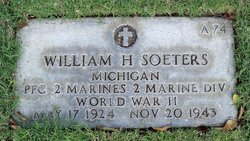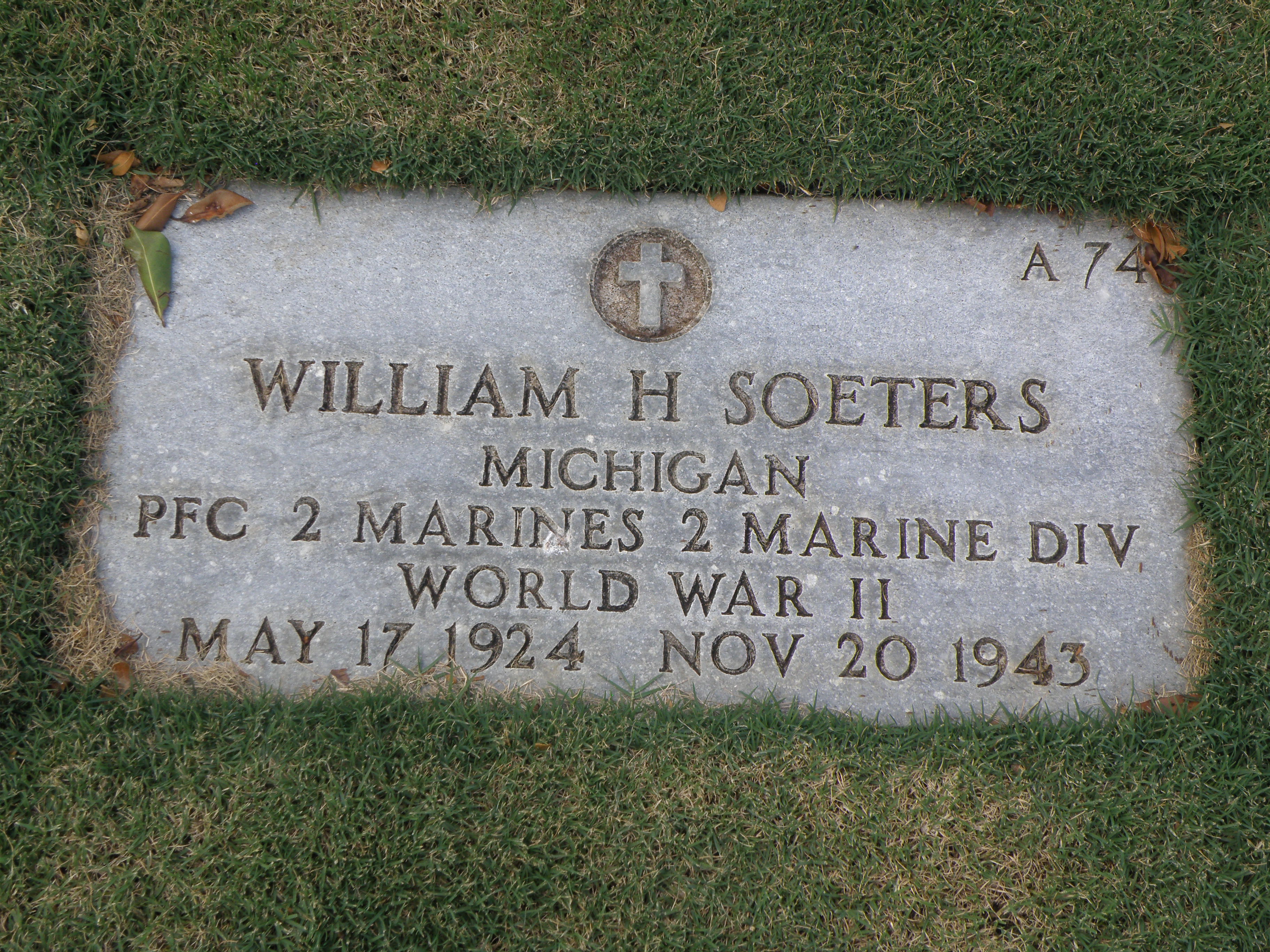Born May 17, 1924, in Kalamazoo, Michigan, William was the 3rd of four children blessed to the union of Dutch immigrants, Marinus and Willemina (nee Toornman) Soeters.
On June 30, 1942, the 6' 1", 160 lb, blue-eyed brunette registered for the draft in his hometown. The 18-year-old was living in his parents 1915 Indiana Avenue home and working for Mr Hays at Matthews Dairy.
Private First Class Soeters was with his brothers in arms when they landed on Betio as part of Operation: GALVANIC. The mission of the 2nd Marine Division was to secure the island in order to control the Japanese airstrip in the Tarawa Atoll; thereby preventing the Japanese Imperial forces from getting closer to the United States, and enabling US forces to get closer to mainland Japan. It would become one of the bloodiest battles in the Corps history.
It was November 20, 1943 (D-Day for the “Battle of Tarawa”), when young William - just 19 years old - perished. He was reportedly soon buried on Betio Island - a temporary location chosen by his fellow Marines, the survivors of the battle, until the Fallen could be recovered and returned to their families.
Having a loved one away from home during the holidays is always trying; however, having a son or husband off fighting in the war left the whole family on edge. The fact that this battle took place just before Thanksgiving meant that most of the families, who had unknowingly earned their Gold Star, would receive their heart-wrenching telegrams on Christmas Eve – some Christmas Day or even New Years Day.
For his service and sacrifice, William's family accepted his awards and decorations, including:
- Purple Heart
- Combat Action Ribbon
- World War II Victory Medal
- American Campaign Medal
- Marine Corps Presidential Unit Citation
- Asiatic-Pacific Theater Campaign Medal
- Marine Corp Expeditionary Medal, and
- Gold Star Lapel Button.
Also left to mourn his passing were siblings; Lebertus John "Bert", Hester Maria (Mrs Harold Kermeen) and Robert Glen "Bob" Soeters. Baby Geraldine passed away before William was born.
Despite the heavy casualties suffered by U.S. forces, military success in the battle of Tarawa was a huge victory for the U.S. military because the Gilbert Islands provided the U.S. Navy Pacific Fleet a platform from which to launch assaults on the Marshall and Caroline Islands to advance their Central Pacific Campaign against Japan.
In the immediate aftermath of the fighting on Tarawa, U.S. service members who died in the battle were buried in a number of battlefield cemeteries on the island. In 1946 and 1947, the 604th Quartermaster Graves Registration Company conducted remains recovery operations on Betio.
William was returned to his family and, on January 10, 1949, laid to rest with full military honors.
SOURCE
Jennifer Morrison, independent volunteer forensic genealogist
Born May 17, 1924, in Kalamazoo, Michigan, William was the 3rd of four children blessed to the union of Dutch immigrants, Marinus and Willemina (nee Toornman) Soeters.
On June 30, 1942, the 6' 1", 160 lb, blue-eyed brunette registered for the draft in his hometown. The 18-year-old was living in his parents 1915 Indiana Avenue home and working for Mr Hays at Matthews Dairy.
Private First Class Soeters was with his brothers in arms when they landed on Betio as part of Operation: GALVANIC. The mission of the 2nd Marine Division was to secure the island in order to control the Japanese airstrip in the Tarawa Atoll; thereby preventing the Japanese Imperial forces from getting closer to the United States, and enabling US forces to get closer to mainland Japan. It would become one of the bloodiest battles in the Corps history.
It was November 20, 1943 (D-Day for the “Battle of Tarawa”), when young William - just 19 years old - perished. He was reportedly soon buried on Betio Island - a temporary location chosen by his fellow Marines, the survivors of the battle, until the Fallen could be recovered and returned to their families.
Having a loved one away from home during the holidays is always trying; however, having a son or husband off fighting in the war left the whole family on edge. The fact that this battle took place just before Thanksgiving meant that most of the families, who had unknowingly earned their Gold Star, would receive their heart-wrenching telegrams on Christmas Eve – some Christmas Day or even New Years Day.
For his service and sacrifice, William's family accepted his awards and decorations, including:
- Purple Heart
- Combat Action Ribbon
- World War II Victory Medal
- American Campaign Medal
- Marine Corps Presidential Unit Citation
- Asiatic-Pacific Theater Campaign Medal
- Marine Corp Expeditionary Medal, and
- Gold Star Lapel Button.
Also left to mourn his passing were siblings; Lebertus John "Bert", Hester Maria (Mrs Harold Kermeen) and Robert Glen "Bob" Soeters. Baby Geraldine passed away before William was born.
Despite the heavy casualties suffered by U.S. forces, military success in the battle of Tarawa was a huge victory for the U.S. military because the Gilbert Islands provided the U.S. Navy Pacific Fleet a platform from which to launch assaults on the Marshall and Caroline Islands to advance their Central Pacific Campaign against Japan.
In the immediate aftermath of the fighting on Tarawa, U.S. service members who died in the battle were buried in a number of battlefield cemeteries on the island. In 1946 and 1947, the 604th Quartermaster Graves Registration Company conducted remains recovery operations on Betio.
William was returned to his family and, on January 10, 1949, laid to rest with full military honors.
SOURCE
Jennifer Morrison, independent volunteer forensic genealogist
Sponsored by Ancestry
Advertisement
Records on Ancestry
-
1930 United States Federal Census
-
Honolulu, Hawaii, U.S., National Memorial Cemetery of the Pacific (Punchbowl), 1941-2011
-
U.S., World War II and Korean Conflict Veterans Interred Overseas
-
U.S., National Cemetery Interment Control Forms, 1928-1962
-
U.S., World War II Draft Cards Young Men, 1940-1947
Sponsored by Ancestry
Advertisement







